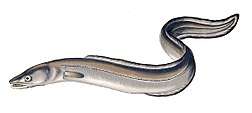Ophichthidae
Ophichthidae is a family of fish in the order Anguilliformes, commonly known as the snake eels. The term "Ophichthidae" comes from Greek ophis ("serpent") and ichthys ("fish"). Snake eels are also burrowing eels, they are named for their physical appearance, they have long, cylindrical snakelike bodies.[2] This family is found worldwide in tropical to warm temperate waters. They inhabit a wide range of habitats, from coastal shallows and even rivers, to depths of above 800 m (2,600 ft).[3] Most species are bottom dwellers, hiding in mud or sand to capture their prey of crustaceans and small fish, but some are pelagic.[4]
| Ophichthidae | |
|---|---|
 | |
| Aprognathodon platyventris | |
 | |
| Myrichthys ocellatus | |
| Scientific classification | |
| Kingdom: | Animalia |
| Phylum: | Chordata |
| Class: | Actinopterygii |
| Order: | Anguilliformes |
| Suborder: | Congroidei |
| Family: | Ophichthidae Günther, 1870 |
| Subfamilies | |
| |
These species range from 5 cm (2.0 in) to 2.3 m (7.5 ft) or more in length. Many species lack fins altogether, improving their ability to burrow into the substrate like worms. They are often spotted or striped in colour, mimicking the appearance of venomous sea snakes to deter predators.[4] Often, they are washed ashore by large storms.
Genera
There are currently 62 recognized genera in this family:
- Subfamily Myrophinae
- Ahlia Jordan & Davis, 1891
- Asarcenchelys McCosker, 1985
- Benthenchelys Fowler, 1934
- Glenoglossa McCosker, 1982
- Mixomyrophis McCosker, 1985
- Muraenichthys Bleeker, 1853
- Myrophis Lütken, 1852
- Neenchelys Bamber, 1915
- Pseudomyrophis Wade, 1946
- Pylorobranchus McCosker & Chen, 2012 [5]
- Schismorhynchus McCosker, 1970
- Schultzidia Gosline, 1951
- Scolecenchelys Ogilby, 1897
- Skythrenchelys Castle & McCosker, 1999
- Sympenchelys Hibino, Ho & Kimura, 2015 [6]
- Subfamily Ophichthinae
- Allips McCosker, 1972
- Aplatophis Böhlke, 1956
- Aprognathodon Böhlke, 1967
- Apterichtus Duméril, 1805
- Bascanichthys Jordan & Davis, 1891
- Brachysomophis Kaup, 1856
- Caecula Vahl, 1794
- Callechelys Kaup, 1856
- Caralophia Böhlke, 1955
- Chauligenion McCosker & Okamoto, 2016 [7]
- Cirrhimuraena Kaup, 1856
- Cirricaecula Schultz, 1953
- Dalophis Rafinesque, 1810
- Echelus Rafinesque, 1810
- Echiophis Kaup, 1856
- Ethadophis Rosenblatt & McCosker, 1970
- Evips McCosker, 1972
- Gordiichthys Jordan & Davis, 1891
- Hemerorhinus Weber & de Beaufort, 1916
- Herpetoichthys Kaup, 1856
- Hyphalophis McCosker & Böhlke, 1982
- Ichthyapus Brisout de Barneville, 1847
- Kertomichthys McCosker & Böhlke, 1982
- Lamnostoma Kaup, 1856
- Leiuranus Bleeker, 1852
- Leptenchelys Myers & Wade, 1941
- Letharchus Goode & Bean, 1882
- Lethogoleos McCosker & Böhlke, 1982
- Leuropharus Rosenblatt & McCosker, 1970
- Luthulenchelys McCosker, 2007
- Malvoliophis Whitley, 1934
- Myrichthys Girard, 1859
- Mystriophis Kaup, 1856
- Ophichthus Ahl, 1789
- Ophisurus Lacépède, 1800
- Paraletharchus McCosker, 1974
- Phaenomonas Myers & Wade, 1941
- Phyllophichthus Gosline, 1951
- Pisodonophis Kaup, 1856
- Quassiremus Jordan & Davis, 1891
- Rhinophichthus McCosker, 1999
- Scytalichthys Jordan & Davis, 1891
- Stictorhinus Böhlke & McCosker, 1975
- Suculentophichthus Fricke, Golani & Appelbaum-Golani, 2015 [3]
- Xestochilus McCosker, 1998
- Xyrias Jordan & Snyder, 1901
- Yirrkala Whitley, 1940
References
| Wikimedia Commons has media related to Ophichthidae. |
- Froese, Rainer, and Daniel Pauly, eds. (2016). "Ophichthidae" in FishBase. June 2016 version.
- Goodson, G. (1988). Fishes of the Pacific Coast: Alaska to Peru, Including the Gulf of California and the Galapagos Islands. Stanford University Press. p. 238. ISBN 978-0804713856.
- Fricke, R., Golani, D. & Appelbaum-Golani, B. (2015): Suculentophichthus nasus, a new genus and new species of snake eel from the northern Gulf of Aqaba, Red Sea (Teleostei: Ophichthidae). Journal of the Ocean Science Foundation, 16: 56–66.
- McCosker, J.E. (1998). Paxton, J.R.; Eschmeyer, W.N. (eds.). Encyclopedia of Fishes, Second Edition. Academic Press. pp. 87–89. ISBN 978-0125476652.
- McCosker, J.E., Loh, K.-H., Lin, J. & Chen, H.-M. (2012): Pylorobranchus hoi, a New Genus and Species of Myrophine Worm-Eel from Taiwan (Anguilliformes: Ophichthidae). Zoological Studies, 51 (7): 1188-1194.
- Hibino, Y., Ho, H.-C. & Kimura, S. (2015): A new genus and species of worm eels, Sympenchelys taiwanensis (Anguilliformes: Ophichthidae: Myrophinae), from the northwestern Pacific Ocean. Zootaxa, 4060 (1): 41–48.
- McCosker, J.E. & Okamoto, M. (2016): Chauligenion camelopardalis, a New Genus and Species of Deepwater Snake Eel (Anguilliformes: Ophichthidae) from the East China Sea. Proceedings of the California Academy of Sciences, 63 (9): 321-328.
